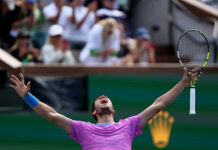From Oaths of the French Revolution to the Spies of World War II

“We have shared the incommunicable experience of war; we have felt, we still feel, the passion of life to its top … In our youth our hearts were touched by fire.”
—Oliver Wendell Holmes
By Bill Simons
As this year’s US Open final was heating up, John McEnroe blurted out, “It’s getting to be a war out there.”
How silly, I thought. The Nadal-Djokovic match was hardly a war. But then I remembered how Jimmy Connors continually claimed that “people always forget it’s a war out there.”
Of course, the great thing about sports is that they sweep aside most of the madness of this bumbling, stumbling world—a little old place the cynical among us claim is a moral wilderness, adrift and mean-spirited. When we take refuge in sports, we escape into a simulated place of play where few are ever killed, only a bit of blood is spilled, and the games themselves don’t really matter one twit.
It just seems that way.
Ultimately our games are a comforting, alternative reality that creates an enticing illusion, a parallel universe that replicates and amplifies life with an almost eerie precision.
Yes, Yannick Noah once said, “I always considered tennis as combat in an arena between two gladiators who have their own rackets and their courage as weapons.”
But let’s be clear, tennis is not—repeat, is not—war: Far from it. Sure, McEnroe and Connors had a point. And some might claim that tennis’ fiercest struggles—well, at least in fleeting moments—suggest the blur of battle. Still, like everything else in life, tennis has been impacted by the blood and angst of real battles. Burning flesh, searing souls, the fog of war has directly or indirectly impacted us all.
———
The connection between war and tennis goes back to the French Revolution, when insurgents hoping to write a kind of pledge of allegiance to democracy were forced to take refuge in an indoor tennis court where they created a rousing, “Down with the King!” pledge, the Tennis Court Oath, which insisted on constitutional rule.
Here in America, the Civil War didn’t have any real connection with tennis until long after the drumbeats of battle were silenced, when a controversial statue of Arthur Ashe was erected on Richmond Virginia’s Monument Avenue in 1996, near an array of statues which celebrate Confederate heroes such as Robert E. Lee, Jefferson Davis, and Stonewall Jackson.
———
The connection of tennis to war and the military goes back to the creation of the modern game and an anonymous British officer—Major Clopton Wingfield—who served in the Dragoon Guards in India and helped Britain take over Beijing. Wingfield—our favorite member of the Honorable Corps of Gentlemen at Arms—went on to create the modern-day version of tennis, first launched on the generous lawns of 19th century English estates. And it’s no accident that, to this day, there is a strong militaristic presence at Wimbledon, where Air Vice-Marshals, Captains, and Colonels often run the place or serve as oh-so-serious volunteers.
Tennis also took a foothold in another world of privilege: Czarist Russia. There, amidst opulent wealth and expansive country castles, flourished a world of underhanded serves, dandy bonnets, and less-than-dandy (poke and push) backhands. All was fun and games for the Czar and his tennis-loving Romanov clan, until the first World War, when the Russian Revolution changed everything.
Around the same time, a dashing World War I flyer, Roland Garros, captured the imagination of the French masses with his spiffy mustache, no-nonsense beret, and deep love of tennis. After he crashed in Tunisia, he became a beloved war martyr. Then, in 1928, when authorities constructed a snazzy tennis palace in Paris, they named the Grand Slam site after the debonair flyer.
By the time of World War I, tennis had become enmeshed in the popular culture. While play was halted at Wimbledon and at the French Nationals, in the great war film, The Grand Illusion, we see French prisoners of war casually tote tennis rackets with a matter-of-fact “tennis, anyone?” ‘tude. All the while, the movie’s hero—Captain de Boeldieu—tells his mates that getting out of the prisoner camp is just another sport to be conquered. “A tennis court,” he says, “is for tennis. A prison camp is for escaping.”
In the real world in 1914, Germany was playing Australia in Pittsburgh, PA of all places, with its large German population, just as World War I broke out. Organizers were told not to announce the outbreak of the conflict for fear of how the Germans would be treated. After the tie, the German team was arrested on the boat that was taking them home and held as prisoners of war.
One of the players who faced Germany was Tony Wilding, the four-time Wimbledon champion. The Nadal of his day, Wilding was said to be the fourth best player in the first 50 years of the 20th century. The stylish New Zealander promptly went to England, where he took the advice of the First Lord of the Admiralty, the young Winston Churchill, and signed up as as a Captain in the Royal Marines. On May 8, 1915, Wilding wrote, “For really the first time in seven-and-a-half months I have a job which is likely to … [have] the whole outfit being blown to hell.” The next day the beloved tennis star, like many others, was indeed blown up.
The years between the two World Wars saw the rise of two of the most notorious dictators in history. Joseph Stalin first consolidated Soviet rule and then led a terrifyingly brutal effort to rebuff Hitler’s unsparing invasion. Russia’s many years of scorched-earth deprivation eventually led to one of the most imaginative pop-sociology theories in tennis, which goes like this: Stalin may have had more impact on 21st century tennis then anyone else. After all, his policies imposed such harsh conditions that many—including a talented cadre of budding young tennis players—did anything they could to escape.
One Russian, Svetlana Kuznetsova, remembered all the difficult times she dealt with as a child and added, “It was not only when we were growing up … It’s also [our grandparents] coming through the war, because our grandparents were fighting in the war and things were extremely hard. They had to fight with nothing, without maybe bullets, only with knives, and still to go to war. They teach their kids to be always strong. Always we have difficult moments in Russia when we grow up, and we always learn to be strong. This is one of the keys [to our success].”
———
With all his theories on the superiority of Aryans and his love of pageantry and propaganda, it was hardly surprising that Adolf Hitler had an interest in sports. He desperately wanted the 1936 Olympics to be a celebration of Ayran superiority, but the African-American track star Jesse Owens made a hash of his ill-conceived racist conceits. Similarly, the Führer eagerly wanted Germany to win the 1937 Davis Cup against the US at Wimbledon. He called Germany’s top player, the aristocratic Baron Gottfried von Cramm, just as he was about to walk on court.
Von Cramm, whose multi-castle family traced their roots to the 12th century, was—after Don Budge and Fred Perry—the best player of his day, as well as the most appealing nobleman in tennis history. Everyone adored the caring guy, who often dropped Baron and von (indicators of noble heritage) from his name. Unlike other German sports heroes (think: boxer Max Schmeling) he refused to be a patsy. He resisted joining the Nazi party, heroically backed a prominent Jewish player who had been banned, and at an exhibition in Australia, had the guts to criticize Hitler.
Not surprisingly, the Nazis retaliated, going after von Cramm’s properties, accusing him of being gay, and sentencing him to a year in prison. Von Cramm’s American friend and rival Don Budge immediately gathered a petition of 25 American standouts (including Joe DiMaggio) in the futile effort to get Hitler to release von Cramm, who eventually had to endure the brutalities of Germany’s eastern front.
Not coincidentally, the mother of the next great star in German tennis, Boris Becker, was also detained during the war. As a Jew, she was imprisoned in a Czech labor camp. According to Jewish law, since Becker’s mother was Jewish, so is Boris. Social historians now chuckle about this twist of fate: three decades after the death of the anti-Semitic Führer, Germany’s greatest sports hero this side of a soccer pitch proved to be a Jew. Hitler’s no doubt double-faulting in his grave.
How sad: the usually oh-so-festive French Open had a dark history during World War II. For ten months in 1939 and 1940, Roland Garros stadium served as a “centre de rassemblement” or prison camp for foreigners and political dissidents, including none other than the famed Arthur Koestler.
The author of Darkness at Noon recalled, “At Roland Garros, we called ourselves the cave dwellers, about 600 of us who lived beneath the stairways of the stadium. We slept on straw—wet straw, because the place leaked. We were so crammed in, we felt like sardines … It smelled of filth and excrement, and only slits of light found their way inside. Few of us knew anything about tennis, but when we were allowed to take our walks in the stadium, we could see the names [of the great French champions Jean] Borotra and [Jacques] Brugnon on the scoreboard.”
Borotra went on to become Commissioner for Sports in the Vichy collaboration government, where he tried to regenerate the supposedly “decadent” French through sports. But the Germans became suspicions about his loyalty, and he was imprisoned in Germany until 1945.
———
The official records of the French Open show that—like the US Open and Wimbledon—the French national championships weren’t played during World War II.
Not true.
While much of tennis shut down (and the Davis Cup was stored in an Australian bank), the sport continued in France between 1941 and 1945, with the fabled Henri Cochet as the head of the French Tennis Federation. At the French National Championships at Roland Garros, the French players Bernard Destremau and Yvon Petra (himself a survivor of a prison camp) prevailed. Even in August, 1944, as Allied forces were driving on Paris from Normandy, Roland Garros went on.
___
In contrast, from 1940 to 1945, there was no play at Wimbledon. Instead, military and civil defense workers gathered. The sporting haven actually became a farm with chickens, pigs, rabbits, and victory gardens. German bombs struck the All-England Club four times, destroying 1,800 seats.
All the while, the best British player of the era, Fred Perry, joined the US Air Force, as did Californian Don Budge. Never mind that Budge, the best player of his day, suffered a severe muscle tear while navigating an obstacle course that seriously diminished his career. He still teamed up with the Coast Guard’s Jack Kramer, Bobby Riggs, an aging Bill Tilden, and many others to play numerous wartime exhibitions.
Wimbledon finalist Tom Brown continued to carry a tennis racquet as he traipsed from battlefield to battlefield. Others had different fates: Chris Evert’s uncle, Jack, died at the age of 22 while in the Army in France, and Californian Joe Hunt, America’s No. 1 player in 1943, perished off of Florida in a 1945 training crash, just months before the war’s end.
Still, no American player had a more intriguing war adventure than Alice Marble. Just before the war, the San Francisco native had won a whopping 19 Slam titles. But in the early ‘40s, the preeminent female player of the day was injured in a car accident, suffered a miscarriage, and lost her flyer husband to Nazi guns over Germany. Then she failed to pull off a suicide attempt.
After all of that, what’s a girl to do? Marble became an American spy in Europe, where she seduced a former lover—a Swiss banker suspected of hiding art and gold—in hopes of gaining Nazi financial data. But the mission went awry, and a Russian agent shot Marble in the back. Still, the info she gathered was used during the Nuremberg Trials to prosecute Nazis, whose horrific war killed millions and changed everything—even a little old game they call tennis.
———
Look in our next issue for part II, covering the Cold War, Vietnam, the Mideast Crisis, and the Balkan Wars.


















